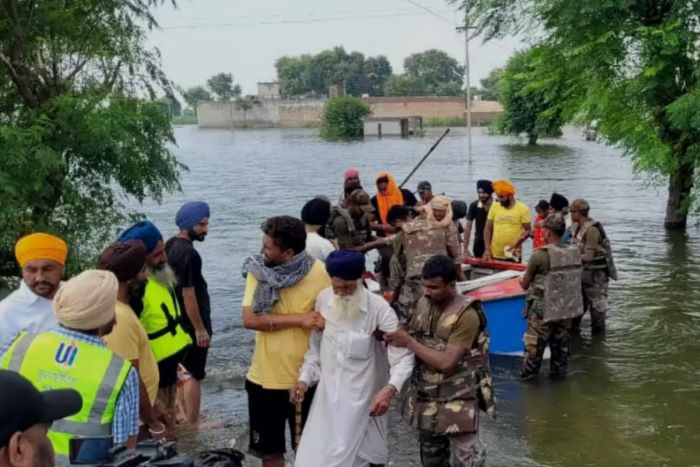 Punjab, the land long known as India’s breadbasket, is facing one of its most difficult periods in recent memory. Heavy monsoon rains have devastated large swathes of the state, turning fertile farmland into vast stretches of waterlogged terrain. Over 1,400 villages have been inundated, crops on nearly 1.75 lakh hectares have been destroyed, and reports suggest that silt up to five feet deep has buried once-productive fields. With a death toll nearing fifty and thousands of families displaced, the floods have caused both human and agricultural distress that will take months, if not years, to recover from.
Punjab, the land long known as India’s breadbasket, is facing one of its most difficult periods in recent memory. Heavy monsoon rains have devastated large swathes of the state, turning fertile farmland into vast stretches of waterlogged terrain. Over 1,400 villages have been inundated, crops on nearly 1.75 lakh hectares have been destroyed, and reports suggest that silt up to five feet deep has buried once-productive fields. With a death toll nearing fifty and thousands of families displaced, the floods have caused both human and agricultural distress that will take months, if not years, to recover from.
The Punjab government has sought additional relief and assistance from the Centre, emphasizing that the ₹1,600 crore package announced by New Delhi is grossly inadequate compared to the scale of losses. State ministers are demanding funds not only for immediate relief but also for long-term measures such as large-scale silt removal, supply of fresh seed varieties, fertilizers, and infrastructure repair. Chief Minister Bhagwant Mann has openly criticized what he sees as the Centre’s lack of empathy, even drawing comparisons between aid to Punjab and international relief packages given to other nations.
For the farming community, the crisis is even deeper. The upcoming paddy procurement season has triggered demands from opposition leaders like Partap Singh Bajwa, who insist on unconditional procurement of the crop this year. Farmers argue that because of excessive rains and flooding, paddy stocks cannot meet the government’s strict moisture content rules, which would normally make them ineligible for purchase. If procurement rules are not relaxed, thousands of farmers could face unbearable losses, adding to Punjab’s already fragile agricultural economy.
Beyond flooding, environmental and public health concerns are also making headlines. The National Green Tribunal (NGT) has issued notices over the discovery of uranium contamination in Punjab’s groundwater, a hazard that could pose long-term health risks. At the same time, Punjab has become the seventh state in India to launch a state-level action plan against antimicrobial resistance, a measure designed to curb the misuse of antibiotics in healthcare, veterinary medicine, and agriculture. Both issues highlight the mounting pressure on the state to balance immediate crisis response with broader public health and environmental safeguards.
On the social front, tensions are surfacing in villages such as those in Barnala and Bathinda, where resolutions have been passed to restrict migrants from buying land or operating as street vendors. These moves are controversial, reflecting deeper anxieties as local communities grapple with crime, unemployment, and resource stress in the wake of repeated natural disasters. Political friction has also flared, with Rahul Gandhi’s recent attempt to visit flood-hit border villages being blocked by police, sparking criticism from the Congress about the AAP government’s handling of relief and access.
Education and institutional policies are adding another layer of concern. A new MBBS bond policy requires medical students to pledge property worth ₹20 lakh or risk expulsion if they do not serve in the state health system after graduation. While the government argues this ensures rural service, many students and families have protested, saying it discriminates against those without significant assets.
Taken together, these developments underscore Punjab’s current crossroads. The floods have exposed weaknesses in water management, embankment maintenance, and floodplain encroachment. Climate change has intensified rainfall patterns, making extreme weather more destructive. At the same time, the state is grappling with migration tensions, health risks, political disputes, and policies that risk alienating the very communities they intend to serve. For Punjab, the challenge is not just about recovering from a single disaster—it is about rethinking resilience, equity, and governance for the future.